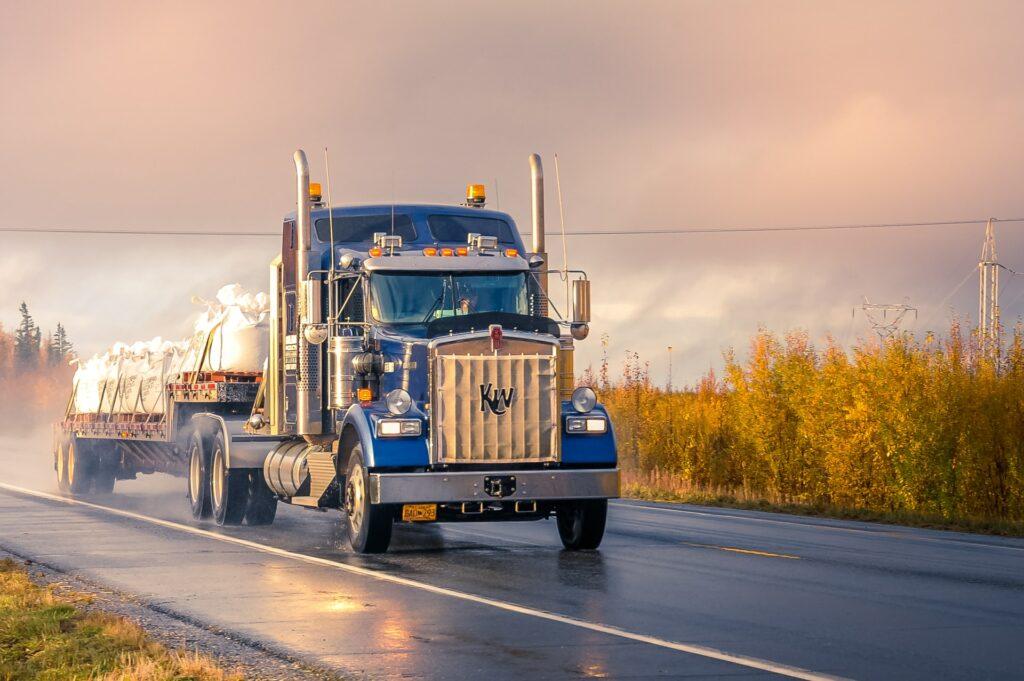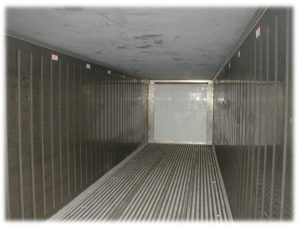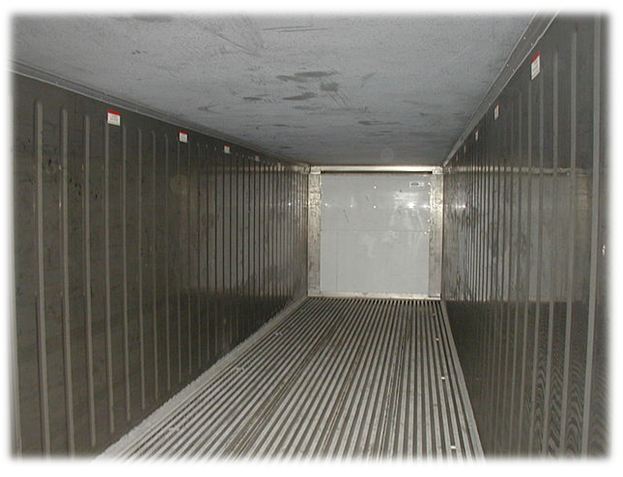Knowing how to tarp a flatbed load safely and properly is an important skill. Note: A tarp is also called a tarpaulin.
Flatbed trucks are equipped with a driver’s cabin and an open cargo bed trailer. The majority of flatbed trailers are leveled to make loading and unloading easier.
The length of a flat-bed comes in various sizes including 24 ft, 40 ft, 45 ft, 48 ft, and 53 ft.
The 48 ft trailers are the most widely used. The 48 ft trailers and other trailers usually have a width of about 102 inches. Flat-beds stand about 60 inches above the ground.
Many flatbeds can scale 46,000 pounds while other trucks may haul more or less.
Because flatbed trucks haul cargo without any sides or roof, they can haul freight such as mobile homes, tree logs, and cars.
Freight carried by flatbed trucks can easily be loaded and unloaded with a crane or forklift.
Drop deck trailers are specially designed to make it easier for the truck to haul taller loads.
Flatbed vs. Step Deck
Flatbed trucks are not to be confused with step deck trucks.
A step-deck and flatbed truck might appear to be similar, but in fact, they are not the same. A step deck truck has a drop in the trailer so that it can haul taller loads. Most step decks usually have a length of 53 ft, 51 ft, or 48 ft. The top deck measures about 10 to 11 feet in length. Then the trailer drops to the bottom deck, approximately 24 inches. One similarity flatbeds and step decks have is that their width is equal at around 102 inches.
A key note that differentiates flatbeds and step-decks is that step-decks cannot haul as much weight. The max a step-deck can pull scales at about 44,000 pounds.
How to safely tarp a load on flatbed trailers
Before you can begin covering a load with a tarp, it is vital that you know and follow safety precautions of securing a load. You will also need to about the different types of truck tarps to decide which one you will be using.
Safety checklist
Ensure you have the following safety equipment before moving to the next step:
High visibility vest
Safety glasses
Good pair of steel toes boot
Long pants
A good pair of gloves
Hard hat
Before I get into the specifics on how to tarp a flatbed load, I will inform you on the different types of tarps.
Steel Tarp
Steel truck tarps are used for loads that carry steel coils and other types of steel freight. They need to be heavy duty, high quality, and cost-friendly. For example, steel truck tarps are ideal to use with steel, rebar, and crafted material.
Steel tarps are usually 24 feet in length and 12 feet in width. If you are using an 8 feet wide trailer, then the tarp will have a 2-3 foot drop on both sides.
Because steel is heavy, it is often the shortest type of load on a flatbed.
A short-sided tarp can cover loads carrying sheet steel and rebar. On a short sided tarp you will find two rows of “D” rings that are stitched onto the four corners.
Steel tarps only require a topside cover to protect it from dirt or rain.
If you are looking to buy a steel tarp you can purchase it through Globalindustrial.com.
Lumber Tarp
Every professional truck driver wants to ensure each load is delivered on-time, safely, and undamaged. To protect lumber loads from the elements, drivers use a lumber tarp.
A lumber tarp is usually 25 feet in length and 24 feet in width.
Lumber tarps are ideal for lumber, trim molding, wall board and more. They hang about 7 feet one each side.
While shopping around, you may discover two types of lumber tarps. Firstly, the tarp may have a flap on the front-end. Flap tarps are perfect for protecting the load from dirt and rain. Flap tarps are also great at preventing parachuting which happens when the wind gets underneath the tarp.
Secondly, the tarp may have a boxed end on the front side. Boxed ends are easy to identify because they have the sides of the flap sewn to the front. They are ideal if you are hauling the same type of load on a regular basis.
Both boxed end and front end lumber tarps have three rows of “D” rings
Whichever you choose, you should know that both boxed end and front end lumber tarps have three rows of “D” rings. The “D” rings are built into the tarp so that you can roll up all the extra fabric and secure the load.
Glass clear tarp
Glass traps are manufactured with a thick weave or fishnet knitted material. They protect the load from road dirt and slime.
Smoke tarp
Smoke tarps are smaller and more rectangular than steel or lumber tarps. They are designed to protect the front of a load from exhaust smoke produced by the truck. It can be used for smaller loads where a full-sized load is not needed. When hauling steel or PVC, a smoke tarp can protect the load from heavy wind.
Occupational Safety and Health Administration (OSHA) Tarping and Fall Protection Guidelines
OSHA has set forth a list of guidelines that must be followed when working with a tarp load. OSHA requires Employers to train their workers with a fall protection method whether applying, adjusting, or removing a tarp. For example, a beam or trolley system or automated tarping system can prevent falls and injuries in the workplace.
If a fall protection system is not in place, there are special tips that you can use to prevent an injury. For instance, fall protection is unavailable when a trucker is conducting vehicle inspections, doing service work, or performing roadside repairs.
Below is a list of safety guidelines created by OSHA:
- Use a ladder to reach the top of the load.
- Wear safety boots that are non-skid.
- Do not ever lift with your back.
- Look for gaps and cracks on the upper part of the load to avoid tripping.
- Stay close to the load’s center line when you are unrolling the tarp.
- Ensure the tarp is parallel to the deck if tie-downs are faulty.
- Make sure to roll tarps properly when putting them away.
- Unroll tarps from the end of the load so that it allows you to push the tarp forward while rolling.
- Get a forklift operator to manage loading the tarps.
How to Tarp a Flatbed Load
After reading the information above, you are now fully prepared to learn how to tarp a flatbed safely and properly.
Step 1: Make sure the load is correctly organized.
Not properly arranging a load before the tarp can cause the cover to tear and damage the freight. Not delivering the load on-time or incomplete can result in a loss of lots of money.
You want to arrange the load properly so that the load’s weight is evenly distributed on the trailer. For instance, the load should not have any high and wide areas. Also, make sure the trailer is parked near a large building so that the tarp covering process is protected from wind resistance.
Step 2: Choose the right tarp
Investing in a good quality tarp can be the difference between a perfect, on-time delivery and a delivery that has damaged freight.
When selecting the best tarp you want one that will be durable and sturdy enough to survive the harshest weather conditions. For example, most heavy (510 grams+) vinyl tarps are protected from ultraviolet radiation and rain. Higher quality tarps will outlast tarps made from polyethylene and canvas.
Also, you want your tarp to have heavy, well-attached grommets. Another key feature to look for when buying a tarp is if it has sewed fabric edges. The edges should have two rows of strong stitches that are woven into the whole tarp.
Step 3: Getting the tarp to the top of the load
Once you have arranged the load and chosen the right tarp, you can move to step 3.
Tarps are usually heavy weighing about 80 pounds. Thus, you will need a forklift operator to lift and place the tarp on the top of the loaded flatbed.
Step 4: Use a ladder to climb to the top of the load
You need to be extra careful when you are performing this action. Ensure that you have a good sturdy ladder that reaches 4 feet above the height of the load. Also, make sure your ladder’s side rails and rungs are in good condition.
You should always check your ladder before climbing atop a load because it is a crucial safety measure.
When you are ready to climb atop the load, inspect it to check for any trip points and make sure that everything looks good.
Step 5: Start tarping
Once you are on the load, you want to begin unrolling facing forward. Unroll the tarp until it is covered evenly from side-to-side. Next, start connecting the tarp to the trailer with rubber tie-downs.
After that, you need to center the tarp. Fold any fabric sticking out on the corners with straps to make sure the wind does not affect the cover.
Use the 4-inch nylon ratchet straps to tie the tarp and load with the trailer.
Your trailer may be built with a ratchet system, and in this circumstance, you will need to hook and secure the straps with the metal bar.
If your tarp has a back flap, you will need to ensure there is a solid seal between the trailer and product. In this case, fold the flap of the tongue up and under so it creates a seal. Next, secure the back flap with the “D” ring.
That is it; you should now be able to tarp a flatbed load!
If you have any questions, please let us know.
How to remove a tarp
Removing a truck tarp is a procedure that needs to be safe and efficient. Firstly, make sure you are wearing your safety gear. Secondly, identify any gaps in the load that might be a safety concern. Next, you need to remove the tie downs and grab a corner to let the wind underneath the tarp. Now, take the tarp off and begin folding. Get assistance from a forklift operator to lift the tarp and transport it to its storage place.
Conclusion
Knowing how to tarp and how to remove a tarp is an essential skill Flatbed drivers must have because tarping ensures that the freight does not get damaged while on the way to its destination. As a flatbed driver, it is your responsibility to learn this necessary. Therefore, it is a good idea for flatbed drivers to seek help when needed.




I am glad you mentioned that when selecting the best tarp you want one that will be durable and sturdy enough to survive the harshest weather conditions. We are looking for a tarp to help secure some products that I need to transport. Thanks for the tips on how to tarp a flatbed.
What type of tarp do I need for hay on a 48 foot trailer
Thanks for the tip that protection from UV rays is also something to be concerned with when it comes to protecting the load on custom truck flatbeds. I’d like to have a truck like that at some point. I think it will be useful to have when I have my own rural property someday and I will need to move furniture around.